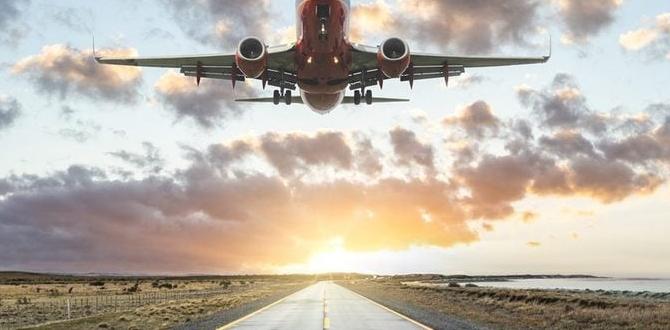Dreaming of a Brazil road trip? This guide shares essential pro tips to make your adventure smooth, safe, and unforgettable. We cover everything from essential gear and planning to navigating local roads and embracing the Brazilian way of travel. Get ready to explore Brazil’s stunning landscapes with confidence!
Embarking on a road trip through Brazil is an incredible way to experience its vast diversity, from sun-drenched beaches to lush rainforests and vibrant cities. However, planning a long journey in a country as large and varied as Brazil can feel a bit overwhelming, especially for first-timers. You might worry about the roads, getting around, or what to pack. But don’t let that stop you! With a little preparation and these expert tips, your Brazil road trip will be a breeze. We’ll guide you through everything you need to know to ensure comfort, safety, and pure adventure, right from the start.
Planning Your Ultimate Brazil Road Trip Base
Brazil is a country of immense scale, and a road trip here isn’t just about the destination; it’s about the journey itself. Having a solid “base guide” – essentially your pre-trip strategy and understanding of what makes a Brazilian road trip unique – is crucial for a successful and enjoyable experience. This section focuses on the foundational elements you need to consider before you even get behind the wheel.
1. Choosing Your Route: More Than Just Dots on a Map
Brazil offers countless road trip possibilities, each with its own charm. Think about what you want to see and do. Are you drawn to the tropical coast, the Amazon basin, or the cosmopolitan energy of its major cities? Researching specific regions is key. For instance, if you’re keen on stunning beaches and charming colonial towns, a route along the Atlantic coast in the Northeast might be perfect. If you’re after natural wonders, the Pantanal or Iguazu Falls are essential stops. Consider the time of year, as weather can significantly impact road conditions and travel experience. For example, heavy rains can affect access to certain areas, especially during the summer months (December to March).
Popular Route Ideas:
- Coastal Charm: From Rio de Janeiro up to Salvador, Bahia, exploring iconic beaches like Copacabana, and historic towns like Paraty and Ilhéus.
- Southern Delights: Exploring the wine regions of Bento Gonçalves, the German heritage in Blumenau, and the dramatic landscapes of the Serra Gaúcha.
- Amazon Gateway: Flying into Manaus and using it as a base for exploring the Amazon by boat and a few accessible by road. Direct road access deep into the Amazon is limited and often challenging.
- Pantanal Explorer: Heading to Campo Grande or Cuiabá as gateways to the world’s largest tropical wetland, great for wildlife spotting.
2. Vehicle Essentials: Your Trusty Travel Companion
Your car is your home on wheels, so ensuring it’s road-ready is paramount. For a Brazil road trip, consider the terrain you’ll be covering. While major highways are generally well-maintained, venturing off the beaten path might require a vehicle with higher clearance. Renting a car is a common option, and it’s wise to opt for a reputable international company for better service and insurance options. Ensure your rental includes proper insurance, and familiarize yourself with its coverage limitations.
Key Vehicle Checks & Recommendations:
- Tire Pressure & Tread: Crucial for safety and fuel efficiency. Check this regularly.
- Fluid Levels: Oil, coolant, brake fluid, and windshield washer fluid.
- Brakes & Lights: Essential for safe driving, especially at night or in varied weather.
- Spare Tire & Tools: Make sure you have a functional spare tire, jack, and lug wrench.
- GPS & Maps: While digital navigation is common, always have a physical map or offline maps downloaded as a backup.
- Vehicle Type: For extensive travel on unpaved roads, consider an SUV or a vehicle with 4WD capabilities. However, for major routes and city hopping, a standard car is usually sufficient.
3. Documentation & Legalities: Paperwork Power
Navigating foreign roads requires proper documentation. Ensure your driver’s license is valid, and consider obtaining an International Driving Permit (IDP). While not always strictly required, it can be a valuable asset if you encounter any official checkpoints or need to communicate your driving credentials. Keep copies of your passport, visa (if applicable), rental agreement, and insurance policy separate from the originals.
It’s also a good idea to be aware of Brazil’s traffic laws. Understanding basic road signs and speed limits is essential. The Brazilian National Land Transport Agency (ANTT) provides essential information on land transport regulations, which can be useful for understanding the broader transport landscape in Brazil.
4. Budgeting for the Open Road: Realistic Expectations
Brazil is a large country, and costs can vary significantly by region. Factor in fuel, accommodation, food, tolls, and potential activities. Fuel prices can fluctuate, so it’s good to keep an eye on them. Accommodation ranges from budget hostels to luxury hotels and charming pousadas (guesthouses). Eating at local “kilo” restaurants (pay-by-weight) can be an affordable and delicious way to experience Brazilian cuisine. Don’t forget to allocate a buffer for unexpected expenses – they often happen on road trips!
A rough daily budget can range from $80-$150 USD per person, depending on your travel style and chosen regions. This typically covers accommodation, food, and some local expenses, but not major inter-state fuel costs or significant tours.
Comfort and Convenience on the Road: Pro Tips
Road trips are all about enjoying the journey comfortably and conveniently. This means packing smart, staying nourished, and being prepared for the day-to-day realities of travel, even for those with specific needs.
5. Packing Smart: Less is More, But Be Prepared
When space is limited, packing strategically is key. Focus on versatile clothing that can be layered for different climates and situations. Comfortable walking shoes are a must, as you’ll likely be exploring diverse terrains. Don’t forget essentials like sunscreen, insect repellent, a basic first-aid kit, and any personal medications.
Must-Have Pack List Items:
- Lightweight, breathable clothing: Cotton and linen are great.
- Swimsuit: You’ll pass many beautiful beaches and waterfalls.
- Rain jacket or poncho: Especially if traveling during the rainy season.
- Comfortable walking shoes/sandals.
- Hat and sunglasses: For sun protection.
- Reusable water bottle: Stay hydrated and reduce plastic waste.
- Travel-sized toiletries: Including hand sanitizer.
- Power adapter and portable charger: To keep your devices powered.
- Basic first-aid kit: Band-aids, antiseptic wipes, pain relievers.
6. Snacks and Hydration: Fueling Your Adventure
Keeping snacks and water handy is crucial for any road trip, especially in Brazil where rest stops might be spread out. Stock up on non-perishable snacks like nuts, dried fruit, granola bars, and crackers. For hydration, carry a large reusable water bottle. While many travellers drink filtered tap water or bottled water, using a water filter bottle can be a sustainable and safe option.
Embrace local snacks as you go! Brazil has incredible regional treats. Look for “pão de queijo” (cheese bread), “açaí bowls,” and various tropical fruits. These are not only delicious but also provide energy for your travels.
7. Personal Comfort Solutions: Staying Confident
For many travelers, maintaining personal comfort is paramount for a stress-free journey. This is where thoughtful packing can make a big difference. For adults who may need extra protection, packing discreet and reliable personal care items is essential. Options like adult diapers designed for daily wear offer security and comfort, allowing you to focus on the experience rather than worries about leaks or discomfort. Brands that emphasize breathability and absorbency are ideal for long drives or exploring humid climates. Packing these items discreetly in your luggage ensures you feel prepared and confident throughout your trip.
Similarly, for families traveling with young children, having access to child diapers and wipes is non-negotiable. Keeping a dedicated bag in the car with changes, along with wipes for quick clean-ups, can save the day. Consider pull-up style diapers for older toddlers, as they are easier to manage during quick stops. Organizations like the US Centers for Disease Control and Prevention (CDC) offer general advice on traveling with children, which includes planning for their comfort and needs.
Tips for Personal Comfort Items:
- Choose breathable, absorbent products: For maximum comfort, especially in warmer climates.
- Pack more than you think you’ll need: Better to have extra than run out.
- Store discreetly: Use packing cubes or designated bags.
- Easy access: Keep a small supply in a readily accessible part of your vehicle for quick changes.
Navigating Brazil’s Roads: Lived In Experience
Driving in Brazil is an experience that differs from many other countries. Understanding local driving habits and road conditions will greatly enhance your safety and enjoyment.
8. Road Quality and Driving Conditions: What to Expect
Brazil has a vast network of federal and state highways. Major federal highways, like the BR-116 (which stretches across the country), are often paved and well-trafficked. However, road quality can vary significantly. Some stretches might be in excellent condition, while others can be riddled with potholes, especially after heavy rains. Smaller state roads and unpaved tracks are common when venturing into more remote areas.
Driving can be more assertive than in some other countries. Expect a variety of vehicles on the road, including trucks, buses, motorcycles, and bicycles. Horns are used frequently, often as a way to signal presence rather than aggression. It’s advisable to drive defensively, maintain a safe distance, and be patient. Many roads, especially in rural areas, lack adequate lighting at night, making night driving potentially hazardous. The World Bank has reports on infrastructure development in Brazil, which can offer insights into road network status.
9. Navigation: Beyond Your Phone’s GPS
While GPS apps like Waze and Google Maps are incredibly useful in Brazil, don’t rely solely on them. Mobile signal can be unreliable in remote areas. Downloading offline maps for the regions you plan to visit is a smart move. Carry a good old-fashioned road atlas as a backup, especially for extensive travel. Also, don’t hesitate to ask locals for directions – they are usually friendly and happy to help, though be prepared for potentially informal directions!
10. Fueling Up: Stations and Services
Gas stations (postos de gasolina) are generally plentiful along major highways. Credit cards are widely accepted, but it’s wise to carry some Brazilian Reais (BRL) cash for smaller, independent stations or in case of any electronic issues. Many gas stations in Brazil offer full service, where an attendant will pump your gas. Tipping for this service is not customary but always appreciated if you feel inclined.
Some gas stations also have convenience stores (many are like mini-supermarkets within the station) and restrooms. However, restroom facilities can be basic, so carrying hand sanitizer is a good idea. Look for reputable chains like Petrobras, Ipiranga, or Shell for more consistent services.
11. Tolls (Pedágios): Budgeting for the Road
Many of Brazil’s main highways are toll roads. The cost of these tolls, known as “pedágios,” can add up. The prices vary from a few Reais to significantly more on longer stretches. You can pay with cash or, in some cases, with electronic toll tags (which are usually integrated into rental car agreements). It’s a good idea to have small denominations of Brazilian Reais on hand to cover these fees. Keep an eye out for toll booths and follow the signage.
Table: Sample Toll Costs on Major Routes (Illustrative)
| Route Segment | Approximate Distance | Estimated Toll Cost (BRL) |
|---|---|---|
| São Paulo to Rio de Janeiro (BR-116) | 430 km | R$ 50 – R$ 70 |
| Curitiba to Florianópolis (BR-101/BR-376) | 300 km | R$ 40 – R$ 60 |
| Salvador to Porto Seguro (BA-001/BR-101) | 600 km | R$ 70 – R$ 90 |
Note: Toll costs are approximate and can change. Always check current rates.
Safety and Security: Peace of Mind on Your Journey
Safety is a priority for any traveler. While Brazil is a wonderfully welcoming country, being aware of your surroundings and taking sensible precautions ensures your trip is enjoyable and secure.
12. Personal Safety: Staying Alert
Like any large country, Brazil has areas where caution is advised. Stick to well-lit and populated areas, especially in cities, and avoid displaying valuable items openly. When driving, keep your doors locked and windows up, particularly in urban traffic where opportunistic theft can occur. Never leave belongings unattended in your car. If you’re unsure about an area, it’s best to ask your hotel or local contacts for advice.
Emergency numbers in Brazil are 190 for Police and 193 for Fire Department. Knowing these can provide extra peace of mind.
13. Vehicle Security: Protecting Your Ride
When parking your car, especially overnight, choose secure parking facilities whenever possible. Hotels with private parking, guarded lots, or well-lit public areas are preferable. Avoid parking on quiet, dark streets. If you notice any strangers showing unusual interest in your vehicle, move to a more public location.
14. Embracing the Local Pace and Culture
One of the most rewarding aspects of a Brazil road trip is immersing yourself in the local culture. Embrace the Brazilian pace of life, which can be more relaxed than you might be used to. Take time to enjoy the scenery, engage with locals (a few Portuguese phrases go a long way!), and savor the culinary delights. Brazilians are known for their warmth and hospitality, and a friendly demeanor can open doors to unforgettable experiences.
Frequently Asked Questions (FAQ)
Q1: Is it safe to drive in Brazil?
Yes, it’s generally safe to drive in Brazil, especially on major highways. However, like any country, it requires awareness. Drive defensively, keep doors locked, avoid night driving in unfamiliar rural areas, and be mindful of your surroundings, particularly in cities. Ensure your car is well-maintained and insured.
Q2: Do I need an International Driving Permit (IDP) to drive in Brazil?
While your standard driver’s license might be accepted in many situations, an International Driving Permit (IDP) is highly recommended. It serves as an official translation of your license and can be helpful for police checks or if you need to rent a car, although many rental agencies are accustomed to foreign licenses. It’s inexpensive and provides an extra layer of preparedness.
Q3: What is the average fuel cost in Brazil 2024?
Fuel costs in Brazil can fluctuate and vary by state. As of early 2024, the average price for gasoline (etanol) was around R$ 5.50 – R$ 6.50 per liter, and for diesel around R$ 5.00 – R$ 6.00 per liter. It’s advisable to check local prices upon arrival. Using apps like Waze can sometimes show real-time fuel prices at nearby stations.
Q4: Can I travel between states easily by road?
Yes, major inter-state travel is very common by road. The federal highway system connects most major cities and states. However, distances are vast, and some routes can be challenging due to road conditions or lack of services. For very long distances, or if time is limited, flying between major hubs and then renting a car might be more efficient.
Q5: What are some common road hazards in Brazil?
Common hazards include potholes, poorly lit roads (especially at night), unexpected speed bumps (lombadas), aggressive or unpredictable driving from other vehicles, animals on rural roads, and sudden weather changes that can affect visibility and road surface. Always maintain a safe speed and be vigilant.
Q6: Is it recommended to use a GPS or navigation app?
Absolutely! GPS and navigation apps like Waze and Google Maps are incredibly useful for real-time traffic updates and directions. However, it’s crucial to download offline maps of your intended routes, as mobile signal can be spotty in many parts




